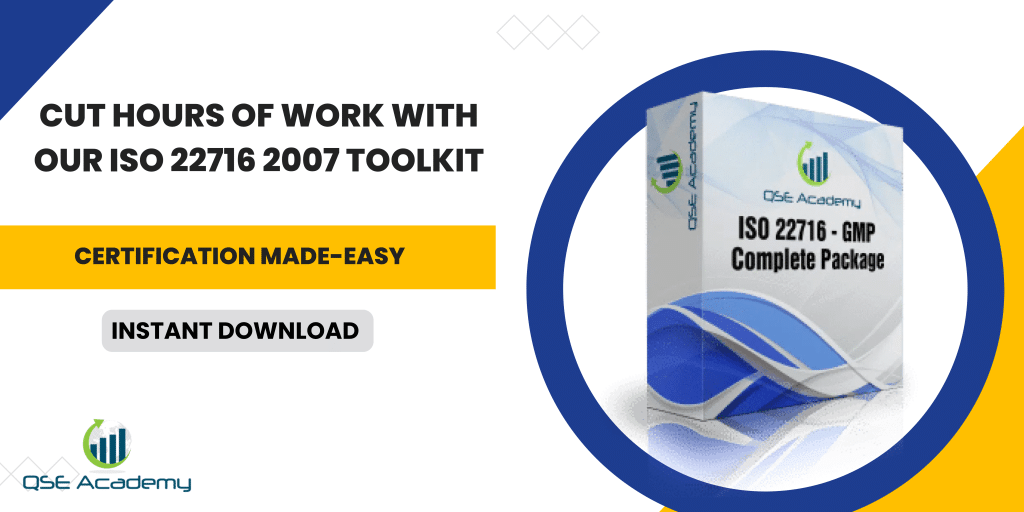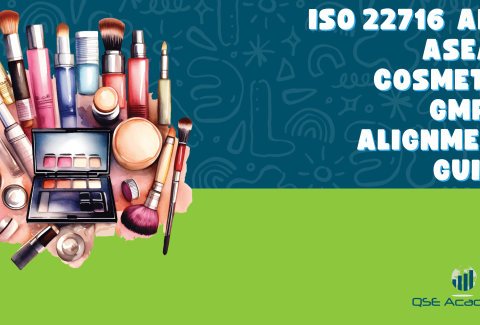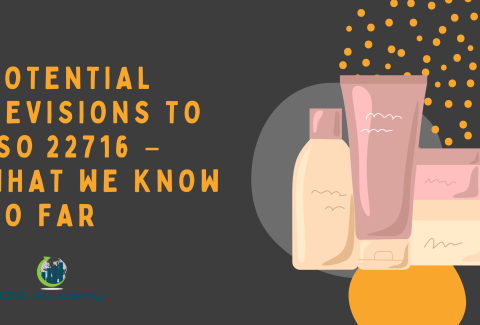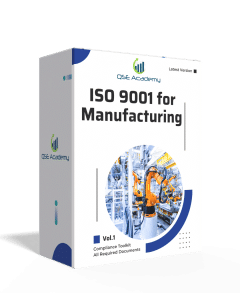ISO 22716 Glossary – Plain‑English Terms
Last Updated on October 24, 2025 by Hafsa J.
Making ISO 22716 Easy to Understand
If you’ve ever tried to read ISO 22716 from start to finish, you know it can feel like wading through technical quicksand. It’s full of terms like CAPA, validation, and traceability — all important, but not exactly self-explanatory. And when you’re running a cosmetic business, you don’t have time to decode regulatory language just to figure out what to do next.
That’s exactly why I created this plain-English glossary. Whether you’re a lab technician, a brand owner, or a quality manager, this guide will help you understand ISO 22716 terms the way they’re meant to be understood — in real, practical context. No jargon, no filler — just clear definitions and quick examples so you can apply them right away.
Let’s break down the key ISO 22716 terms that every cosmetic manufacturer should know.
GMP (Good Manufacturing Practice)
Let’s start with the heart of it all — GMP, or Good Manufacturing Practice.
If ISO 22716 were a story, GMP would be the main character. It’s the set of rules and habits that keep your cosmetics safe, consistent, and traceable.
In simple terms, GMP means doing things right, every time, no matter who’s on shift or how busy production gets. It covers everything — from how you clean equipment and store raw materials, to how you train staff and handle packaging.
ISO 22716 is the official GMP guide for cosmetics. It doesn’t reinvent the wheel; it just explains how to apply GMP in a cosmetic environment.
Example:
Think of GMP like a recipe. Follow it step by step — same ingredients, same process, same care — and you’ll get consistent, safe results every time. Skip a step, and you risk contamination, recalls, or regulatory trouble.
Pro tip:
Even if you’re not certified, showing that you follow GMP principles under ISO 22716 builds massive trust with clients and regulators. It’s proof that you take quality seriously.
Batch Record
A Batch Record is simply the written story of how each product batch was made — from start to finish. It’s one of the most important documents in ISO 22716 because it connects every ingredient, person, and piece of equipment to the final product.
Think of it as your product’s “birth certificate.” It should tell you:
-
What ingredients were used (and how much)
-
Who did the mixing, filling, and labeling
-
What equipment and lot numbers were involved
-
Any checks, deviations, or test results along the way
If a customer complaint or recall ever happens, your batch record is the first thing regulators will ask for. It shows whether your process was under control.
Example:
If a moisturizer batch causes irritation complaints, your batch record lets you trace it back to a specific ingredient lot or process step — so you can find the root cause instead of guessing.
Pro tip:
Don’t treat batch records as admin work. They’re your insurance policy. A clean, complete record can protect your company during an audit or investigation.
Deviation
In ISO 22716, a deviation simply means something didn’t go according to plan. It’s any event or action that strays from your written procedures — whether that’s using the wrong batch label, skipping a temperature check, or noticing an unexpected result during production.
Deviations aren’t bad by themselves — they’re signals. They tell you that your system caught an issue before it became a bigger problem. The key is how you respond.
When you record a deviation, you’re showing that you noticed, investigated, and took steps to correct or prevent it from happening again. That’s what auditors and regulators want to see: awareness and control.
Example:
You discover a batch of shampoo was filled at a slightly higher viscosity than specified. Instead of ignoring it, you document it as a deviation, investigate the cause (maybe a mixing speed issue), and update your process. That’s smart GMP in action.
Pro tip:
Don’t hide or delete deviations to “look compliant.” Regulators trust transparency. A company that admits to small deviations but shows a solid response always earns more credibility than one with “no issues” on record.
CAPA (Corrective and Preventive Action)
CAPA stands for Corrective and Preventive Action, and it’s one of the cornerstones of ISO 22716. It’s how you fix problems — and more importantly, how you make sure they don’t happen again.
When something goes wrong (a deviation, a complaint, or an audit finding), the corrective action is what you do to fix the issue immediately. The preventive action is what you put in place to stop it from reoccurring — like retraining staff, revising an SOP, or improving equipment maintenance.
Example:
Let’s say a mislabeled batch reaches your warehouse. The corrective action is to isolate the batch and relabel it properly. The preventive action might be adding a second label verification step before packaging starts.
Pro tip:
CAPA isn’t about assigning blame — it’s about learning. The best manufacturers treat every CAPA as a small win because each one makes the system stronger and more reliable.
Common pitfall:
Filing CAPA reports just to “close the issue” without checking whether the fix actually worked. Always verify the results — otherwise, you’re just moving the problem forward.
SOP (Standard Operating Procedure)
An SOP, or Standard Operating Procedure, is simply a written instruction that explains how to perform a specific task — the right way, every time. In ISO 22716, SOPs are the backbone of your system. They turn good intentions into repeatable results.
Every part of your process should have an SOP — from mixing and labeling to cleaning equipment and handling complaints. When written well, SOPs keep everyone aligned, even when staff changes or production scales up.
Example:
An SOP for “Equipment Cleaning” might list what detergents to use, how long to soak, the order of rinsing, and how to verify cleanliness. That way, whoever does it next — whether a new hire or your most experienced technician — does it exactly the same way.
Pro tip:
Don’t write SOPs no one wants to read. Keep them clear, visual, and realistic. The best SOPs are built with input from the people who actually do the work — they’ll spot the small details that make a big difference.
Common pitfall:
Copying generic SOPs from the internet. They might impress an auditor for a minute, but they won’t reflect your actual processes — and that’s a red flag during an inspection.
PIF (Product Information File)
The Product Information File, or PIF, is one of the most critical documents under EU Regulation 1223/2009 — and ISO 22716 plays a big part in supporting it. Think of the PIF as the complete technical and safety dossier for every cosmetic product you place on the market.
It must include everything that proves your product is safe, compliant, and properly made. That means:
-
The full formula and ingredient details
-
Safety assessment and toxicological data
-
Proof of GMP compliance (your ISO 22716 system)
-
Labeling and artwork copies
-
Test results and claims substantiation
The PIF is legally required and must be kept available at the Responsible Person’s address for inspection. Authorities can request it anytime, so it needs to be organized, complete, and always up to date.
Example:
If an EU inspector questions a product’s preservative level or labeling, the PIF is where you prove your formula was safe, your process controlled, and your documentation aligned with ISO 22716 standards.
Pro tip:
Keep your PIF and GMP records synchronized. Whenever a formula, supplier, or packaging changes — update both. A mismatch between your records and your actual product is one of the fastest ways to get a nonconformity.
Common pitfall:
Treating the PIF as a “one-time setup.” It’s a living document — and it should evolve as your products and processes do.
Responsible Person (RP)
In the world of EU cosmetics, the Responsible Person (RP) is the one who holds the legal accountability for compliance. Under EU Regulation 1223/2009, every cosmetic product must have an officially designated RP before it’s sold on the market — and that person or company must be based within the EU.
The RP isn’t just a figurehead. They’re responsible for making sure every product meets safety, labeling, and GMP requirements. That includes ensuring manufacturing follows ISO 22716 principles, maintaining the Product Information File (PIF), and managing product notifications in the CPNP system (the Cosmetic Product Notification Portal).
Example:
If you’re a UK or non-EU brand selling in Europe, your EU distributor or a compliance consultant can act as your RP — but they’ll need your full cooperation and documentation to take on that role legally.
Pro tip:
Choose your RP carefully. They’re the first point of contact if regulators raise a concern about your product. Make sure they have the technical expertise to interpret ISO 22716 requirements, not just fill out forms.
Common pitfall:
Assuming your manufacturer automatically serves as your RP. In many cases, the RP is a separate legal entity — and unless the arrangement is written and signed, the liability falls on you, the brand owner.
The RP is the bridge between your production and your compliance — they make sure what you produce is also legally marketable.
Internal Audit
An Internal Audit is your built-in reality check — a structured way to see whether your team is actually following ISO 22716 requirements the way they’re written. It’s less about catching people doing things wrong and more about verifying that your system works the way it should.
Think of it as your early warning system. Internal audits let you find gaps before external auditors or regulators do. They give you the chance to correct problems quietly, improve documentation, and strengthen your processes over time.
Example:
You might review a random batch record and realize one operator forgot to sign off a cleaning step. That’s a small issue — but spotting it during an internal audit allows you to fix the process and retrain staff before it shows up during certification or inspection.
Pro tip:
Treat internal audits as routine maintenance, not punishment. Schedule them quarterly or twice a year, rotate auditors if possible, and always share results constructively. The goal is improvement, not fault-finding.
Common pitfall:
Waiting until right before a certification or surveillance audit to “check everything.” That creates stress and last-minute errors. Continuous internal reviews keep you audit-ready year-round — and make external audits smoother.
Regular internal audits are what keep ISO 22716 from becoming just a document system — they keep it alive, accurate, and truly effective.
Recall / Complaint Handling
Even the best manufacturers get complaints — it’s what you do next that defines your credibility. Under ISO 22716, you’re expected to have clear, written procedures for handling customer complaints and managing product recalls when necessary.
A complaint is any feedback that suggests a product didn’t meet expectations or caused an issue. A recall is when you actively remove a product from the market because it may pose a health or safety risk. Both require traceability, documentation, and quick action.
Example:
Let’s say a customer reports skin irritation after using your face cream. You’d log the complaint, check the batch record, and investigate whether the issue came from formulation, contamination, or misuse. If you find a safety concern, you may need to issue a recall — and ISO 22716 ensures you can trace and remove that batch efficiently.
Pro tip:
Don’t panic when a complaint arrives — treat it as valuable data. Every complaint is a chance to identify weak spots and improve product safety. Regulators respect companies that respond fast and document every step.
Common pitfall:
Handling complaints informally — through emails or calls — without official documentation. If it’s not recorded, it didn’t happen in the eyes of an auditor. Create a simple complaint form and train your staff to use it consistently.
Handled right, complaint management isn’t just damage control — it’s part of building a responsible, trustworthy brand.
Traceability
Traceability is one of those terms that sounds technical but is actually very practical. In ISO 22716, it simply means being able to track where everything came from and where it went — every ingredient, every packaging material, and every finished batch.
If something goes wrong, traceability is what lets you pinpoint the issue quickly. You should be able to say exactly:
-
Which supplier provided a specific raw material
-
Which batches that ingredient was used in
-
Where those batches were shipped or sold
That level of visibility isn’t just for regulators — it’s what protects your business when problems arise.
Example:
If you discover that a preservative from a supplier was contaminated, you can trace every batch that used it and recall only those specific units — instead of pulling all your products off the shelves. That precision saves time, money, and reputation.
Pro tip:
Use lot numbers consistently. They’re the backbone of traceability. Every label, record, and test result should include the lot or batch number — it ties everything together.
Common pitfall:
Keeping traceability records in multiple spreadsheets or notebooks without cross-referencing. In an audit or recall, disorganized data can cause delays — or worse, noncompliance. A simple, centralized record system makes all the difference.
Traceability isn’t about tracking for the sake of it — it’s about proving control and protecting your customers when it matters most.
Validation
Validation in ISO 22716 means proving — not just assuming — that your process consistently delivers the results you expect. It’s about evidence. You test, observe, and confirm that your methods, equipment, and procedures actually work in practice, not just on paper.
Think of validation as your confidence check. You’re showing that your cleaning method really removes residue, that your filling machine always dispenses the right volume, or that your mixing process ensures even ingredient distribution.
Example:
If you fill 100 bottles of serum and half come out slightly underfilled, you can’t claim your filling process is validated. Once you test, adjust, and consistently get accurate fills, then you’ve proven it works — that’s validation.
Pro tip:
Document your validation process thoroughly: the test conditions, results, and any adjustments made. Auditors will want to see proof, not just a statement saying “validated.”
Common pitfall:
Skipping validation because a process “has always worked.” That’s risky — especially if you ever change equipment, formulas, or packaging. Any change means your validation might need to be redone to confirm nothing else was affected.
Validation isn’t about adding bureaucracy; it’s about proving that your confidence in your process is backed by data, not assumption.
FAQs – Quick Clarifications
1. Do I need to memorize every ISO 22716 term?
Not at all. What matters is understanding how each concept fits into your daily operations. When you know what “batch record” or “CAPA” means in practice, you can apply them naturally. Think of this glossary as a reference, not a vocabulary test.
2. What’s the easiest way to train staff on these terms?
Keep it visual and practical. Create a one-page “GMP glossary” poster for your lab or production area. Use short explanations and examples your team can relate to — it’s far more effective than long manuals no one reads.
3. Are these terms used globally or just in the EU?
Most are universal. ISO 22716 is recognized worldwide, and its terminology aligns with other GMP systems in places like ASEAN, the Middle East, and South America. Once your team understands these concepts, they’ll be comfortable with nearly any regulator’s expectations.
Turning ISO 22716 Jargon into Practical Know-How
ISO 22716 might sound intimidating at first, but once you break down the terminology, it becomes surprisingly practical. Every term — from batch record to validation — exists for one reason: to help you make safer, more consistent products.
Understanding these words isn’t about passing an audit; it’s about building confidence in how you work. When your team knows what each concept means and why it matters, they make better decisions, spot risks faster, and keep your system running smoothly.
Pro tip: Don’t keep ISO language locked in the quality office. Use it daily — in production meetings, training sessions, and even supplier reviews. The more your people use the vocabulary, the more naturally compliance becomes part of your culture.
At QSE Academy, we’ve helped countless cosmetic brands simplify GMP by turning regulatory jargon into clear, usable actions. If you want a quick visual reference, download our “ISO 22716 Glossary Cheat Sheet.” It’s a plain-English guide you can share with your whole team.
Because in cosmetics manufacturing, clarity isn’t just helpful — it’s compliance.
Whether it’s ISO 9001, ISO 22000, or the cosmetics-focused ISO 22716, I’ve spent my career I’m not here to call myself an expert—I prefer “enthusiast” because I truly love what I do. When I’m not writing about standards, you’ll probably find me playing Piano 🎹, connecting with people, or diving into my next big project💫. I’m an engineer specialized in the food and agricultural industry
make ISO standards less intimidating and more approachable for everyone.
turning complex jargon into clear, actionable steps that businesses can actually use.
There’s something incredibly rewarding about helping people navigate food safety and quality management systems
in a way that feels simple, practical, and even enjoyable.
I have a Master’s in QHSE management and over 12 years of experience as a Quality Manager
I’ve helped more than 15 companies implement ISO 9001, ISO 22000, ISO 22716, GMP, and other standards
My clients include food producers, cosmetics manufacturers, laboratories, and service companies
I believe quality systems should be simple, useful, and efficient.











